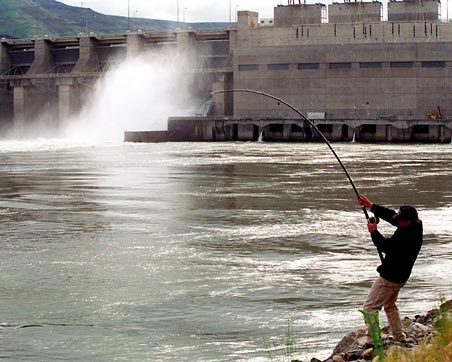forum
library
tutorial
contact

Salmon and Dams Can Coexist
on the Snake River
by Cathy McMorris Rodgers
The Seattle Times, September 12, 2007
|
the film forum library tutorial contact |

|
Salmon and Dams Can Coexist
by Cathy McMorris Rodgers
|
 The Snake and Columbia river system is vital to the Pacific Northwest. It has transformed our region from a barren and dry desert to a vibrant agricultural center; helped build our high-tech and manufacturing economy by providing reliable, low-cost energy; allowed us to ship our produce around the world; and created a wide variety of recreational opportunities.
The Snake and Columbia river system is vital to the Pacific Northwest. It has transformed our region from a barren and dry desert to a vibrant agricultural center; helped build our high-tech and manufacturing economy by providing reliable, low-cost energy; allowed us to ship our produce around the world; and created a wide variety of recreational opportunities.
Salmon are also an important part of our regional culture and heritage, and I believe that salmon and dams can coexist. Salmon recovery in the Northwest is a complex issue, and requires a comprehensive regionwide effort. Dam removal is not the answer. It would have a devastating impact on our region's energy and transportation infrastructure, and may do little to even help salmon listed as threatened or endangered.
First, our dams should not be singled out when studying salmon recovery. Some believe that legislation introduced by Rep. Jim McDermott, the Salmon Economic Analysis and Planning Act, is the best course of action in the process to restore and protect endangered salmon runs. But this bill unfairly targets the four lower Snake River dams and fails to take a comprehensive look at all factors impacting salmon runs.
If the goal of this bill is truly to gather scientific data on how to best preserve and restore salmon and steelhead species, then more should be studied than just the Snake River dams - especially since only four of the 26 listed salmon species even pass through the Snake River.
Second, dam removal would hurt our economy. It would take more than 10 years and $1.1 billion to breach these dams. In 2002, the U.S. Army Corps of Engineers stated that "the lower Snake dams and locks, including salmon programs, cost $36.5 million per year to maintain, while the dams produce $324 million per year in electricity, barge transportation benefits, and water."
Hydroelectric dams provide over 67 percent of our region's electricity. More importantly, these dams provide clean, renewable energy. It would take three nuclear, six coal-fired, or 14 gas-fired power plants to provide the peaking capacity of the four Snake River dams. Having clean, affordable hydropower helps reduce our reliance on foreign oil imports and supports the region's booming wind-power industry by ensuring that there's electricity when the wind isn't blowing.
In addition, river transportation would need to be replaced with trucks and rails, which would contribute to more carbon dioxide emissions. It would take 120 semi trucks to replace just one barge. The cost to rebuild the transportation infrastructure in the state of Washington alone would be approximately $1 billion.
Crops grown in the Pacific Northwest are exported to countries around the world and the best way to transport them is through our river systems. The Columbia-Snake River system is the No. 1 U.S. wheat export gateway and No. 1 U.S. barley export gateway; it is No. 1 in West Coast paper and paper products exports, and No. 1 in West Coast mineral bulk exports, supporting $15 billion in international trade. Why would we put that in jeopardy?
Finally, salmon decline cannot be attributed to just our dams. Salmon returns in the Pacific Northwest have rebounded to record levels in recent years in response to improved technology at the dams, habitat improvements and changing ocean conditions. According to the National Oceanic and Atmospheric Administration Fisheries, salmon survival in the Columbia and Snake rivers is higher today than it was before the dams were built. Predation, overharvest and ocean conditions all have a major impact on salmon numbers and should be addressed with the same fervor as dam modification.
We need a comprehensive regional approach to salmon restoration where salmon and dams can coexist. Dams provide low-cost, clean, renewable energy and are a key piece of our transportation infrastructure. Our ultimate goal must be to find a balanced approach that preserves our environment and protects the economic interests of the region.
(bluefish points out that the Congresswoman provides statistics relevant to the Columbia river system and not statistics pertinent to the Lower Snake River system alone.)
Related Pages:
When Fish Come Before Humans, Something is Wrong by Sonya D. Jones, Idaho Statesman, 9/4/7
Salmon Numbers Remain Low by Greg Moore, Idaho Mountain Express, 9/5/7
learn more on topics covered in the film
see the video
read the script
learn the songs
discussion forum
